Towards Scalable Large-Area Pulsed Laser Deposition
Abstract
:1. Introduction
2. Materials and Methods
3. Results and Discussion
- –
- changing the scanning range—Upper Limit and Lower Limit parameters;
- –
- changing the coordinate in which the scanning speed reaches its maximum—Origin parameter;
- –
- varying the smoothness of changes in scanning speeds—Upper Coefficient и Lower Coefficient parameters.
4. Conclusions
Supplementary Materials
Author Contributions
Funding
Institutional Review Board Statement
Informed Consent Statement
Data Availability Statement
Acknowledgments
Conflicts of Interest
References
- Blank, D.H.A.; Dekkers, M.; Rijnders, G. Pulsed laser deposition in Twente: From research tool towards industrial deposition. J. Phys. D Appl. Phys. 2013, 47, 034006. [Google Scholar] [CrossRef]
- Ahn, Y.; Son, J.Y. Growth and ferroelectric properties of highly c-oriented epitaxial Aurivillius BaBi4Ti4O15 thin films. Mater. Sci. Eng. C 2021, 266, 115046. [Google Scholar] [CrossRef]
- Li, T.; Dong, J.; Zhang, N.; Wen, Z.; Sun, Z.; Hai, Y.; Wang, K.; Liu, H.; Tamura, N.; Mi, S.; et al. Interface control of tetragonal ferroelectric phase in ultrathin Si-doped HfO2 epitaxial films. Acta Mater. 2021, 207, 116696. [Google Scholar] [CrossRef]
- Khan, M.A.; Braic, L.; AlSalik, Y.; Idriss, H. Growth of epitaxial strontium titanate films on germanium substrates using pulsed laser deposition. Appl. Surf. Sci. 2021, 542, 148601. [Google Scholar] [CrossRef]
- Najim, A.A. Synthesis and characterizations of (δ-Bi2O3)0.93(TiO2)0.07 thin films grown by PLD technique for optoelectronics. Mater. Sci. Semicond. Process. 2017, 71, 378–381. [Google Scholar] [CrossRef]
- Liu, G.Z.; Lei, Q.Y.; Xi, X.X. Stoichiometry of SrTiO3 films grown by pulsed laser deposition. Appl. Phys. Lett. 2012, 100, 202902. [Google Scholar] [CrossRef]
- Narayan, R.J. Pulsed laser deposition of functionally gradient diamondlike carbon–metal nanocomposites. Diam. Relat. Mater. 2005, 14, 1319–1330. [Google Scholar] [CrossRef]
- Socol, G.; Socol, M.; Stefan, N.; Axente, E.; Popescu-Pelin, G.; Craciun, D.; Duta, L.; Mihailescu, C.N.; Mihailescu, I.N.; Stanculescu, A.; et al. Pulsed laser deposition of transparent conductive oxide thin films on flexible substrates. Appl. Surf. Sci. 2012, 260, 42–46. [Google Scholar] [CrossRef]
- Fourmont, P.; Gerlein, L.F.; Fortier, F.X.; Cloutier, S.G.; Nechache, R. Highly efficient thermoelectric microgenerators using nearly room temperature pulsed laser deposition. ACS Appl. Mater. Interfaces 2018, 10, 10194–10201. [Google Scholar] [CrossRef]
- Karnati, P.; Haque, A.; Taufique, M.F.N.; Ghosh, K. A systematic study on the structural and optical properties of vertically aligned zinc oxide nanorods grown by high pressure assisted pulsed laser deposition technique. Nanomaterials 2018, 8, 62. [Google Scholar] [CrossRef] [PubMed] [Green Version]
- Vakulov, Z.E.; Zamburg, E.G.; Khakhulin, D.A.; Ageev, O.A. Thermal stability of ZnO thin films fabricated by pulsed laser deposition. Mater. Sci. Semicond. Process. 2017, 66, 21–25. [Google Scholar] [CrossRef]
- Ji, X.; Wang, C.; Harumoto, T.; Tian, Y.; Zhang, S.; Tu, R.; Shen, Q.; Shi, J. Deposition-temperature dependence of structure, ferroelectric property and conduction mechanism of BCZT epitaxial films. Ceram. Int. 2021, 47, 3195–3200. [Google Scholar] [CrossRef]
- Tominov, R.V.; Vakulov, Z.E.; Avilov, V.I.; Khakhulin, D.A.; Fedotov, A.A.; Zamburg, E.G.; Smirnov, V.A.; Ageev, O.A. Synthesis and Memristor Effect of a Forming-Free ZnO Nanocrystalline Films. Nanomaterials 2020, 10, 1007. [Google Scholar] [CrossRef] [PubMed]
- Tominov, R.V.; Vakulov, Z.E.; Avilov, V.I.; Khakhulin, D.A.; Polupanov, N.V.; Smirnov, V.A.; Ageev, O.A. The Effect of Growth Parameters on Electrophysical and Memristive Properties of Vanadium Oxide Thin Films. Molecules 2021, 26, 118. [Google Scholar] [CrossRef] [PubMed]
- Al-Kattan, A.; Grojo, D.; Drouet, C.; Mouskeftaras, A.; Delaporte, P.; Casanova, A.; Robin, J.D.; Magdinier, F.; Alloncle, P.; Constantineskus, C.; et al. Short-Pulse Lasers: A Versatile Tool in Creating Novel Nano-/Micro-Structures and Compositional Analysis for Healthcare and Wellbeing Challenges. Nanomaterials 2021, 11, 712. [Google Scholar] [CrossRef] [PubMed]
- Koster, G.; Blank, D.H.; Rijnders, G.A. Oxygen in Complex Oxide Thin Films Grown by Pulsed Laser Deposition: A Perspective. J. Supercond. Nov. Magn. 2020, 33, 205–212. [Google Scholar] [CrossRef] [Green Version]
- Tominov, R.V.; Smirnov, V.A.; Avilov, V.I.; Fedotov, A.A.; Klimin, V.S.; Chernenko, N.E. Formation of ZnO memristor structures by scratching probe nanolithography. IOP Conf. Ser. Mater. Sci. Eng. 2018, 443, 012036. [Google Scholar] [CrossRef] [Green Version]
- Fernández-Arias, M.; Boutinguiza, M.; Del Val, J.; Riveiro, A.; Rodríguez, D.; Arias-González, F.; Gil, J.; Pou, J. Fabrication and deposition of copper and copper oxide nanoparticles by laser ablation in open air. Nanomaterials 2020, 10, 300. [Google Scholar] [CrossRef] [Green Version]
- Ageev, O.A.; Gusev, E.Y.; Zamburg, E.G.; Vakulov, D.E.; Vakulov, Z.E.; Shumov, A.V.; Ivonin, M.N. Nanocrystalline ZnO films grown by PLD for NO2 and NH3 sensor. Appl. Mech. Mater. 2014, 475, 446–450. [Google Scholar]
- Karapetyan, G.Y.; Kaydashev, V.E.; Zhilin, D.A.; Kutepov, M.E.; Minasyan, T.A.; Kaidashev, E.M. A surface acoustic wave impedance-loaded high sensitivity sensor with wide dynamic range for ultraviolet light detection. Sens. Actuator A Phys. 2019, 296, 70–78. [Google Scholar] [CrossRef]
- Nguyen, M.D.; Houwman, E.P.; Yuan, H.; Wylie-van Eerd, B.J.; Dekkers, M.; Koster, G.; tel Elshof, J.E.; Rijnders, G. Controlling piezoelectric responses in Pb(Zr0.52Ti0.48)O3 films through deposition conditions and nanosheet buffer layers on glass. ACS Appl. Mater. Interfaces 2017, 9, 35947–35957. [Google Scholar] [CrossRef] [PubMed]
- Smirnov, V.A.; Tominov, R.V.; Avilov, V.I.; Alyabieva, N.I.; Vakulov, Z.E.; Zamburg, E.G.; Ageev, O.A. Investigation into the Memristor Effect in Nanocrystalline ZnO Films. Semiconductors 2019, 53, 72–77. [Google Scholar] [CrossRef]
- Greer, J.A.; Tabat, M.D. Large-area pulsed laser deposition: Techniques and applications. J. Vac. Sci. Technol. A 1995, 13, 1175–1181. [Google Scholar] [CrossRef]
- Greer, J.A.; Tabat, M.D.; Lu, C. Future trends for large-area pulsed laser deposition. Nucl. Instrum. Methods Phys. Res. 1997, 121, 357–362. [Google Scholar] [CrossRef]
- Smith, H.M.; Turner, A.F. Vacuum deposited thin films using a ruby laser. Appl. Opt. 1965, 1, 147–148. [Google Scholar] [CrossRef]
- Venkatesan, T.; Wu, X.; Inam, A.; Chang, C.C.; Hegde, M.S.; Dutta, B. Laser processing of high-T/sub c/superconducting thin films. IEEE J. Quantum. Electron. 1989, 25, 2388–2393. [Google Scholar] [CrossRef]
- Pryds, N.; Schou, J.; Linderoth, S. The spatial thickness distribution of metal films produced by large area pulsed laser deposition. Appl. Surf. Sci. 2007, 253, 8231–8234. [Google Scholar] [CrossRef]
- Marcu, A.; Grigoriu, C.; Jiang, W.; Yatsui, K. Pulsed laser deposition of YBCO thin films in a shadow mask configuration. Thin Solid Films 2000, 360, 166–172. [Google Scholar] [CrossRef]
- Lackner, J.M. Industrially-scaled large-area and high-rate tribological coating by pulsed laser deposition. Surf. Coat. Technol. 2005, 200, 1439–1444. [Google Scholar] [CrossRef]
- Greer, J.A. History and current status of commercial pulsed laser deposition equipment. J. Phys. D Appl. Phys. 2013, 47, 034005. [Google Scholar] [CrossRef] [Green Version]
- Yang, H.; Wang, W.; Liu, Z.; Li, G. Epitaxial growth of 2 inch diameter homogeneous AlN single-crystalline films by pulsed laser deposition. J. Phys. D Appl. Phys. 2013, 46, 105101. [Google Scholar] [CrossRef]
- Eason, R.W.; May-Smith, T.C.; Grivas, C.; Darby, M.S.B.; Shepherd, D.P.; Gazia, R. Current state-of-the-art of pulsed laser deposition of optical waveguide structures: Existing capabilities and future trends. Appl. Surf. Sci. 2009, 255, 5199–5205. [Google Scholar] [CrossRef]
- Christen, H.M.; Eres, G. Recent advances in pulsed-laser deposition of complex oxides. J. Phys. Condens. Matter. 2008, 20, 264005. [Google Scholar] [CrossRef] [PubMed] [Green Version]
- Ageev, O.; Konoplev, B. (Eds.) Nanotechnology in Microelectronics; Nauka Publisher: Moscow, Russia, 2019; p. 511. [Google Scholar]
- Inogamov, N.A.; Zhakhovskii, V.V.; Ashitkov, S.I.; Petrov, Y.V.; Agranat, M.B.; Anisimov, S.I.; Nishihara, K.; Fortov, V.E. Nanospallation induced by an ultrashort laser pulse. J. Exp. Theor. Phys. 2008, 107, 1–19. [Google Scholar] [CrossRef]
- Agranat, M.B.; Anisimov, S.I.; Ashitkov, S.I.; Zhakhovskii, V.V.; Inogamov, N.A.; Nishihara, K.; Petrov, Y.V.; Fortov, V.E.; Khokhlov, V.A. Dynamics of plume and crater formation after action of femtosecond laser pulse. Appl. Surf. Sci. 2007, 253, 6276–6282. [Google Scholar] [CrossRef]
- Eason, R. Pulsed Laser Deposition of Thin Films: Applications-Led Growth of Functional Materials, 1st ed.; Wiley: New York, NY, USA, 2007; p. 681. [Google Scholar]
- Ageev, O.A.; Dostanko, A.P.; Zamburg, E.G.; Konoplev, B.G.; Polyakov, V.V.; Cherednichenko, D.I. Effect of the processes in the laser ablation plume on the resistivity and morphology of nanocrystalline ZnO films. Phys. Solid State 2015, 57, 2093–2098. [Google Scholar] [CrossRef]
- Anisimov, S.I.; Luk’Yanchuk, B.S. Selected problems of laser ablation theory. Phys.-Uspekhi 2002, 45, 293–324. [Google Scholar] [CrossRef] [Green Version]
- Vakulov, Z.; Geldash, A.; Khakhulin, D.; Il’ina, M.V.; Il’in, O.I.; Klimin, V.S.; Dzhuplin, V.N.; Konoplev, B.G.; He, Z.; Ageev, O.A. Piezoelectric Energy Harvester Based on LiNbO3 Thin Films. Materials 2020, 13, 3984. [Google Scholar] [CrossRef]
- Lee, M.H.; Park, J.S.; Kim, M.H.; Song, T.K.; Kumar, S.; Kim, W.J.; Do, D.; Hwang, I.; Park, B.H.; Choi, K.S. Lead-free piezoelectric BiFeO3-BaTiO3 thin film with high Curie temperature. Curr. Appl. Phys. 2016, 16, 1449–1452. [Google Scholar] [CrossRef]
- Spreitzer, M.; Egoavil, R.; Verbeeck, J.; Blank, D.H.; Rijnders, G. Pulsed laser deposition of SrTiO3 on a H-terminated Si substrate. J. Mater. Chem. C 2013, 1, 5216–5222. [Google Scholar] [CrossRef]
- McGee, R.; Goswami, A.; Khorshidi, B.; McGuire, K.; Schofield, K.; Thundat, T. Effect of process parameters on phase stability and metal-insulator transition of vanadium dioxide (VO2) thin films by pulsed laser deposition. Acta Mater. 2017, 137, 12–21. [Google Scholar] [CrossRef]
- Socol, M.; Preda, N.; Rasoga, O.; Costas, A.; Stanculescu, A.; Breazu, C.; Gherendi, F.; Socol, G. Pulsed laser deposition of indium tin oxide thin films on nanopatterned glass substrates. Coatings 2019, 9, 19. [Google Scholar] [CrossRef] [Green Version]
- De Bonis, A.; Teghil, R. Ultra-Short Pulsed Laser Deposition of Oxides, Borides and Carbides of Transition Elements. Coatings 2020, 10, 501. [Google Scholar] [CrossRef]
- Trzciński, K.; Szkoda, M.; Gazda, M.; Karczewski, J.; Cenian, A.; Grigorian, G.M.; Sawczak, M. Pulsed Laser Deposition of Bismuth Vanadate Thin Films—The Effect of Oxygen Pressure on the Morphology, Composition, and Photoelectrochemical Performance. Materials 2020, 13, 1360. [Google Scholar] [CrossRef] [PubMed] [Green Version]
- Tominov, R.V.; Smirnov, V.A.; Chernenko, N.E.; Ageev, O.A. Study of the regimes of scratching probe nanolithography. Nanotechnologies Russ. 2017, 12, 650–657. [Google Scholar] [CrossRef]
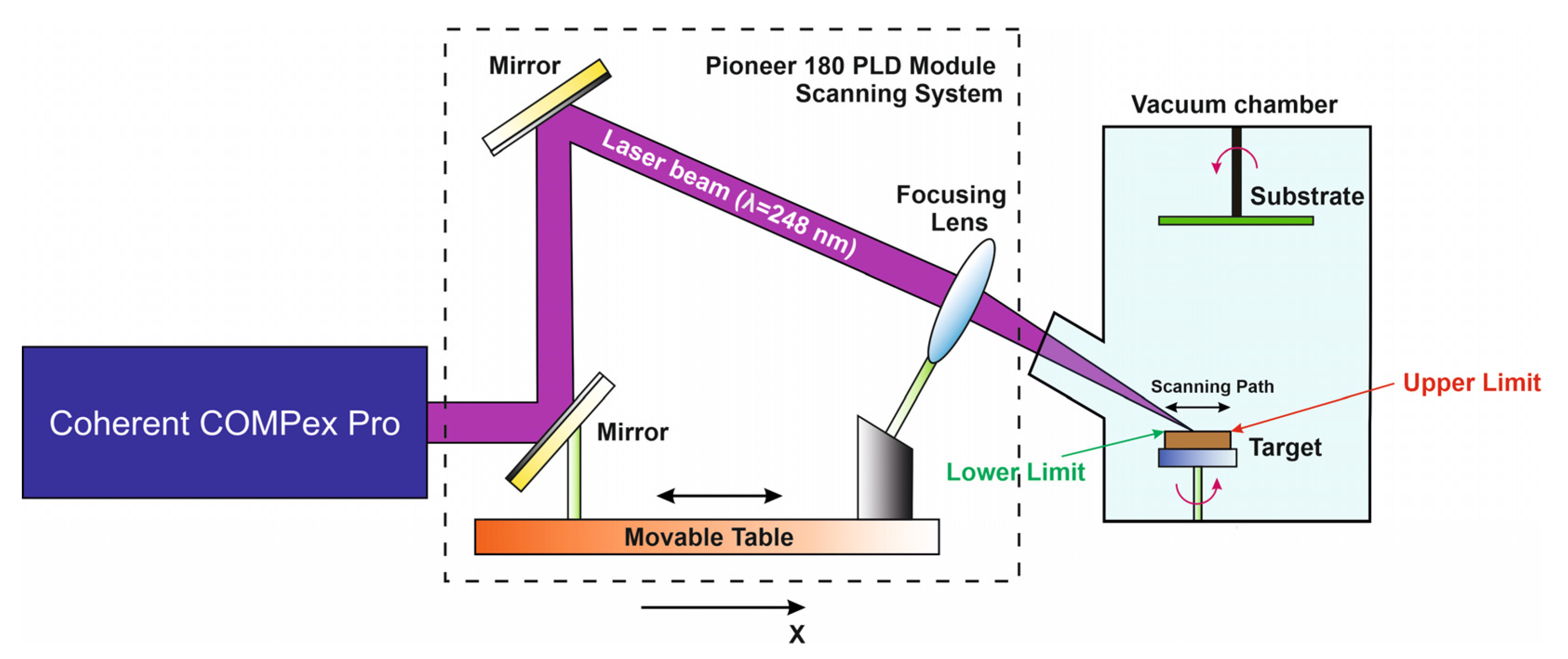
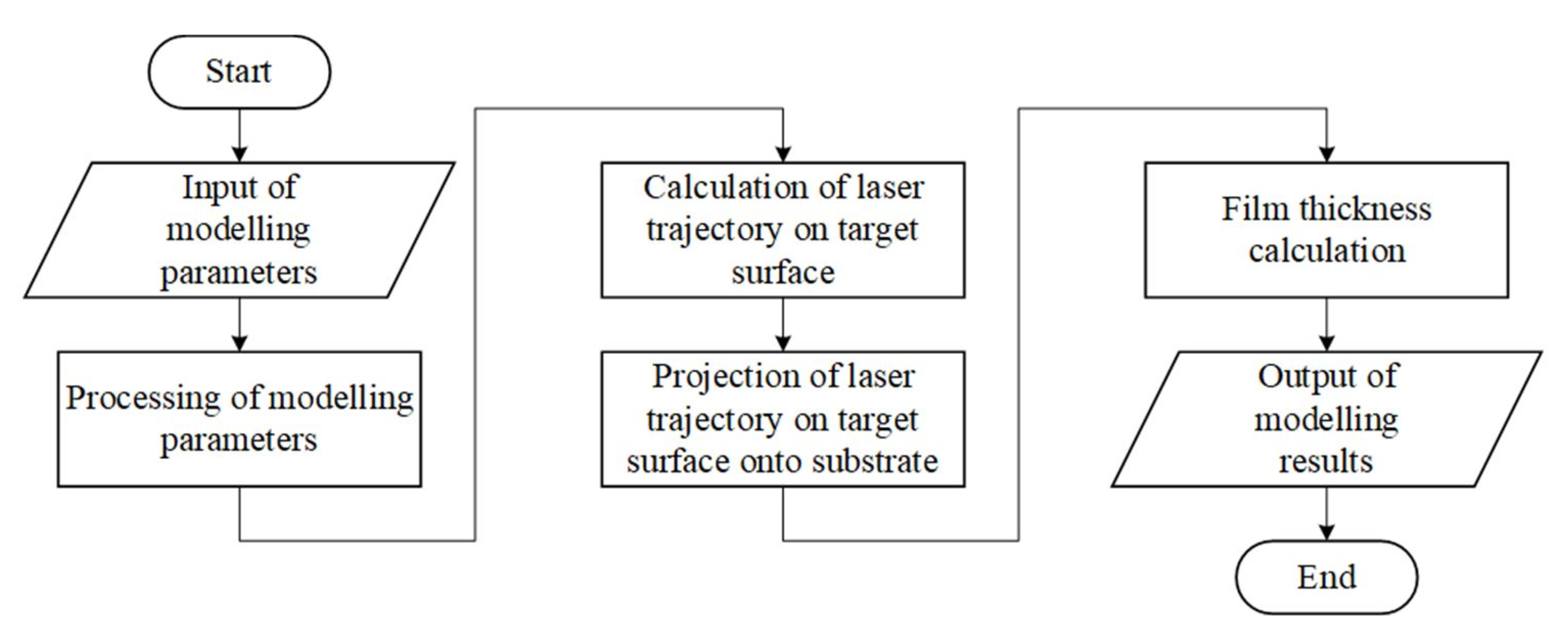


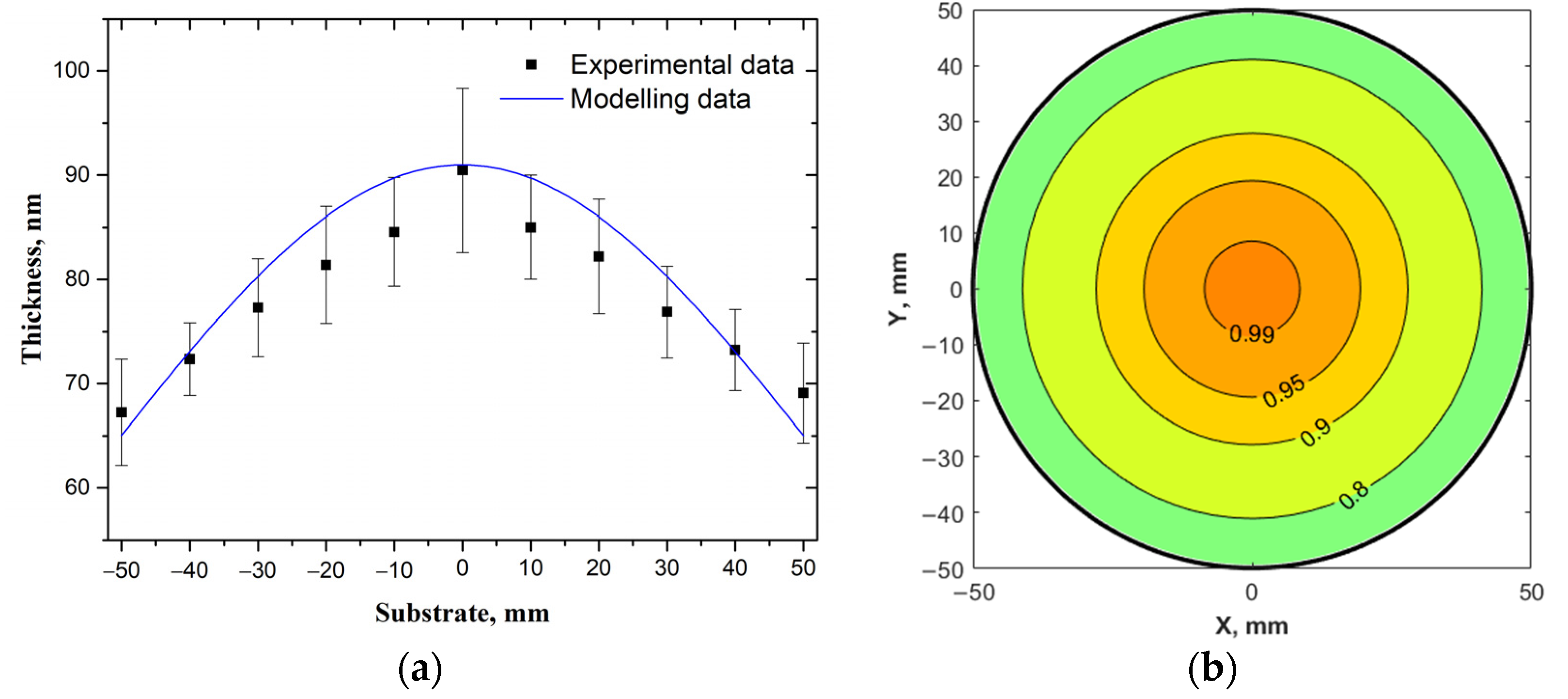
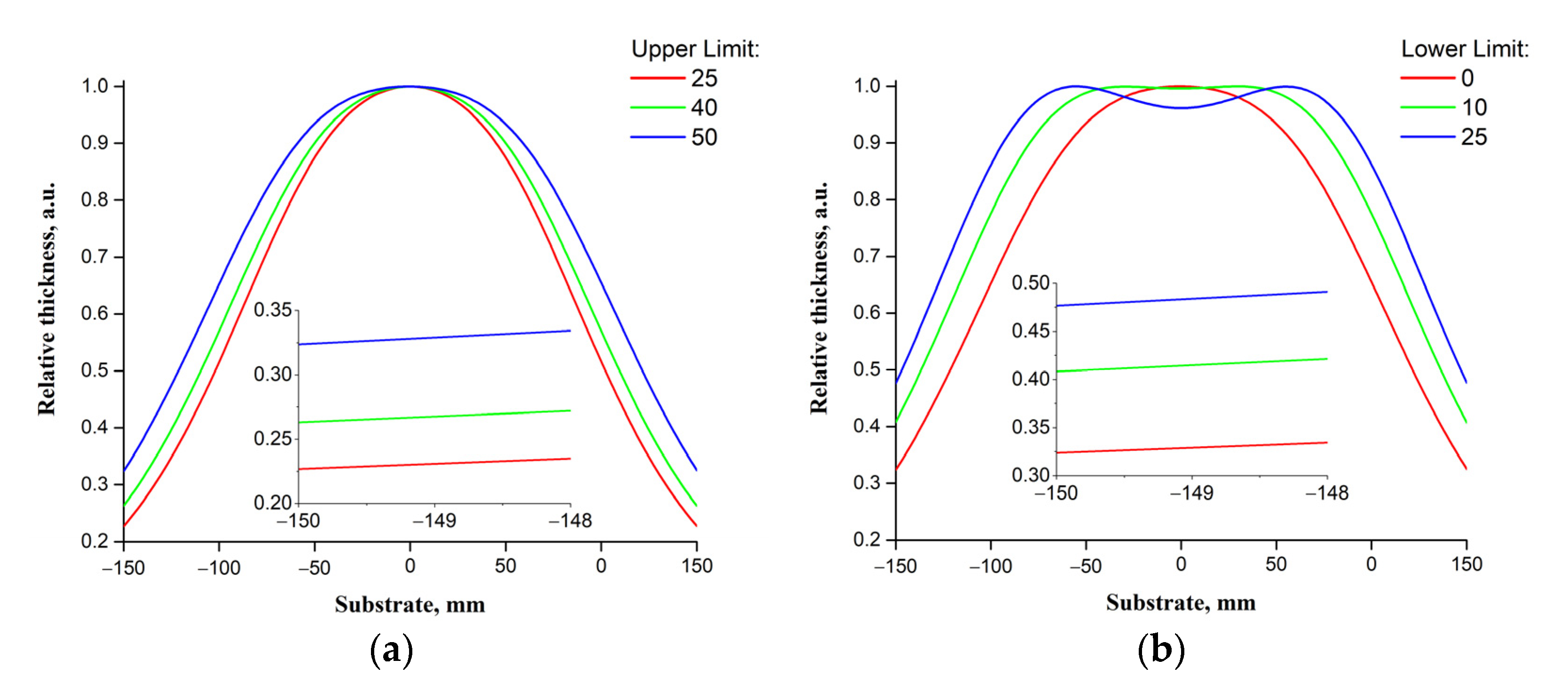
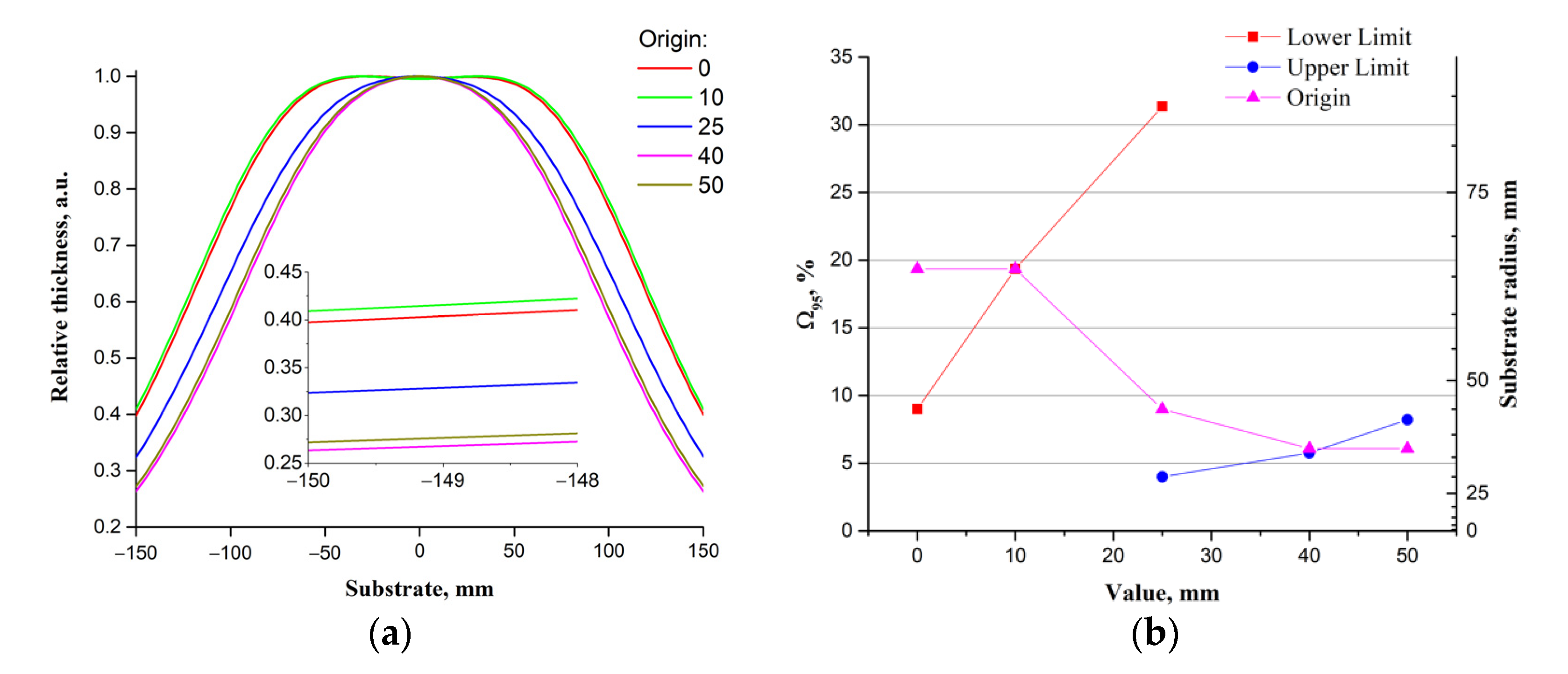

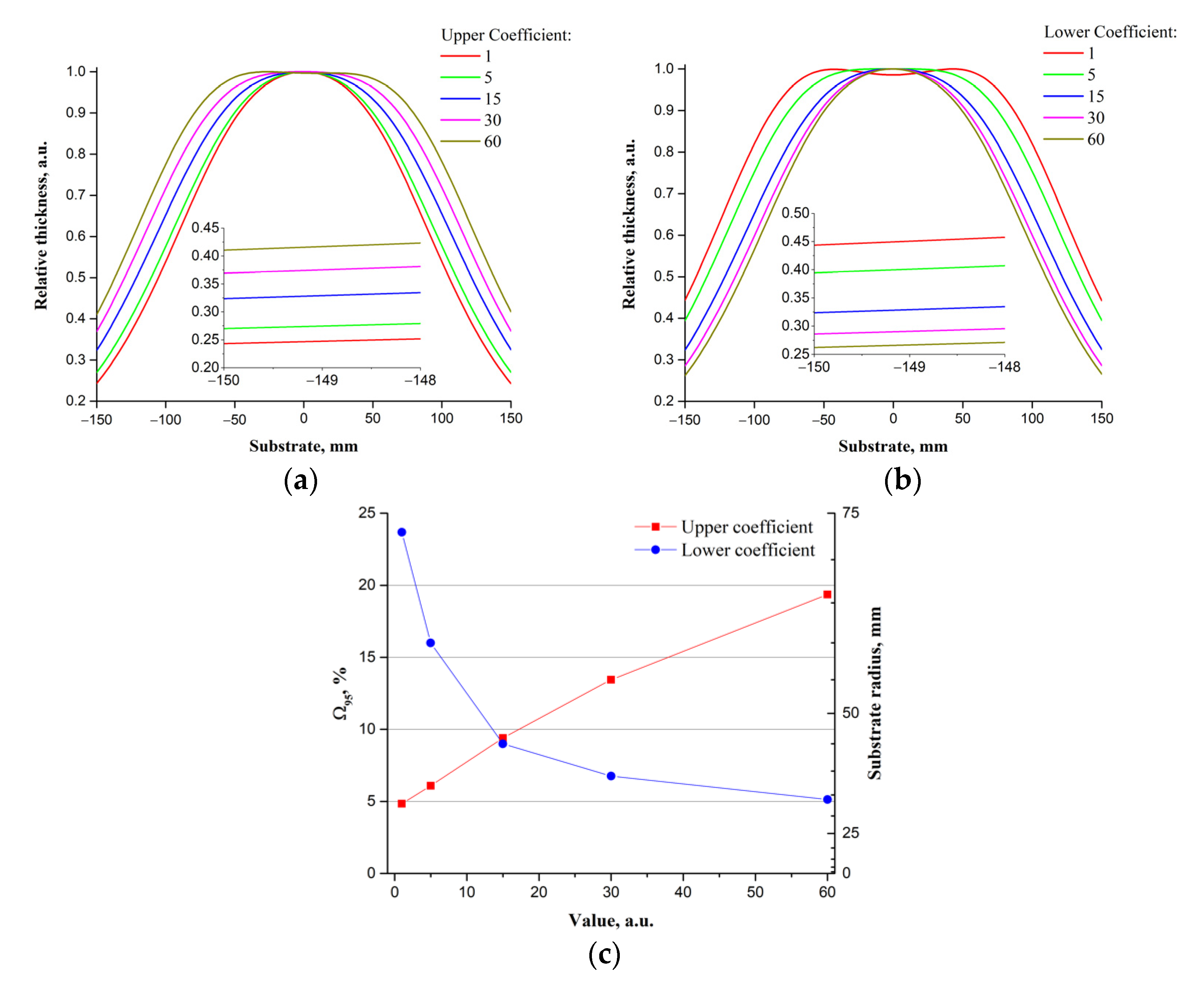
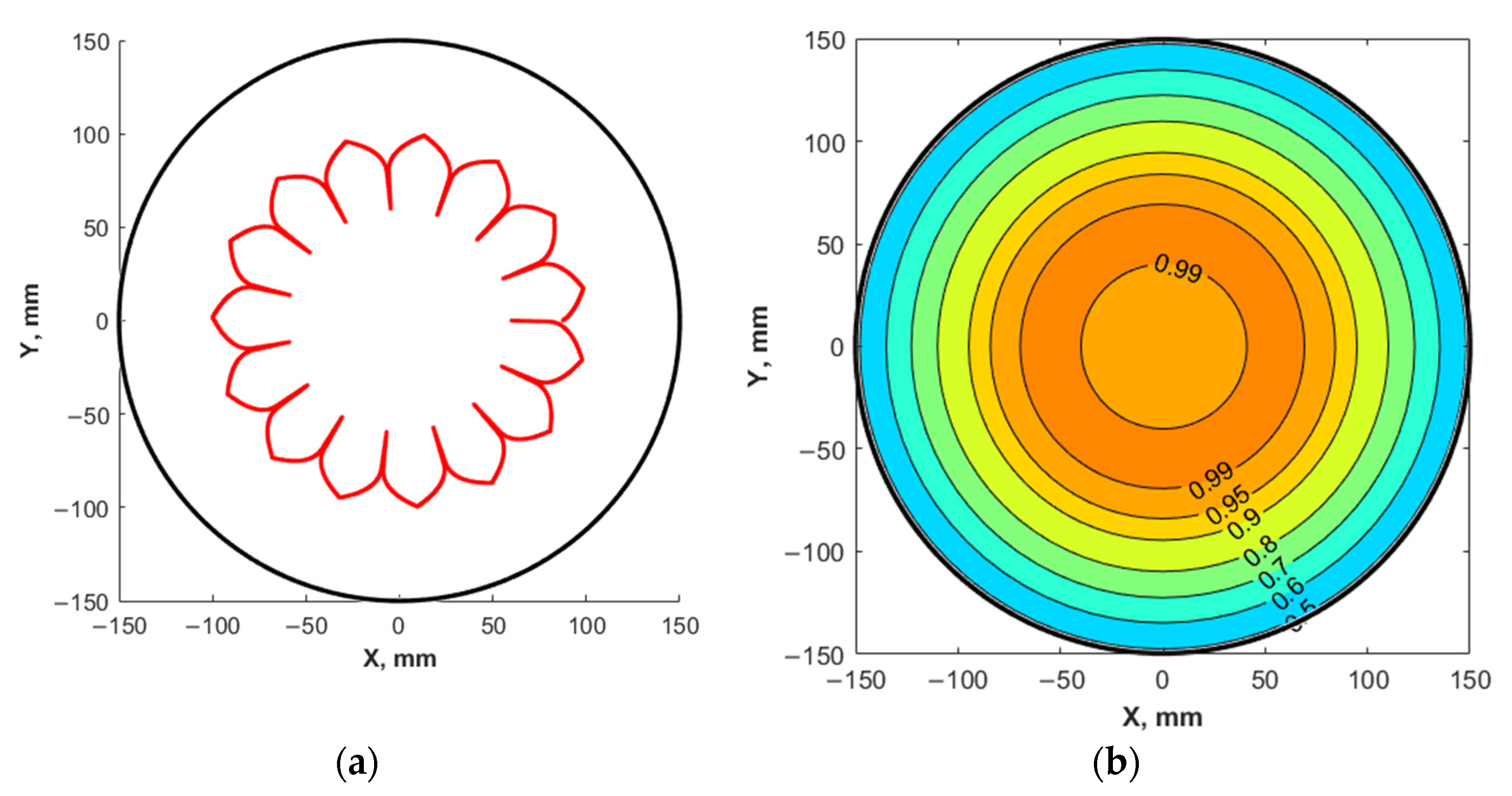
| Technological Parameters | |||||
| Number of laser pulses | 36,000 | ||||
| Laser pulse repetition rate | 10 Hz | ||||
| Substrate diameter | 300 mm | ||||
| Target diameter | 50 mm | ||||
| Target-substrate distance | 75 mm | ||||
| Target rotation speed | 10 °/s | ||||
| Substrate rotation speed | 0.1 °/s | ||||
| Scanning System Parameters (default parameters are highlighted) | |||||
| Origin | 0 | 10 | 25 | 40 | 50 |
| Upper Limit | 25 | 40 | 50 | ||
| Lower Limit | 0 | 10 | 25 | ||
| Maximum Velocity | 5 | 10 | 20 | ||
| Minimum Velocity | 0.1 | 1 | 5 | ||
| Lower Coefficient | 1 | 5 | 15 | 30 | 60 |
| Upper Coefficient | |||||
Publisher’s Note: MDPI stays neutral with regard to jurisdictional claims in published maps and institutional affiliations. |
© 2021 by the authors. Licensee MDPI, Basel, Switzerland. This article is an open access article distributed under the terms and conditions of the Creative Commons Attribution (CC BY) license (https://creativecommons.org/licenses/by/4.0/).
Share and Cite
Vakulov, Z.; Khakhulin, D.; Zamburg, E.; Mikhaylichenko, A.; Smirnov, V.A.; Tominov, R.; Klimin, V.S.; Ageev, O.A. Towards Scalable Large-Area Pulsed Laser Deposition. Materials 2021, 14, 4854. https://doi.org/10.3390/ma14174854
Vakulov Z, Khakhulin D, Zamburg E, Mikhaylichenko A, Smirnov VA, Tominov R, Klimin VS, Ageev OA. Towards Scalable Large-Area Pulsed Laser Deposition. Materials. 2021; 14(17):4854. https://doi.org/10.3390/ma14174854
Chicago/Turabian StyleVakulov, Zakhar, Daniil Khakhulin, Evgeny Zamburg, Alexander Mikhaylichenko, Vladimir A. Smirnov, Roman Tominov, Viktor S. Klimin, and Oleg A. Ageev. 2021. "Towards Scalable Large-Area Pulsed Laser Deposition" Materials 14, no. 17: 4854. https://doi.org/10.3390/ma14174854






